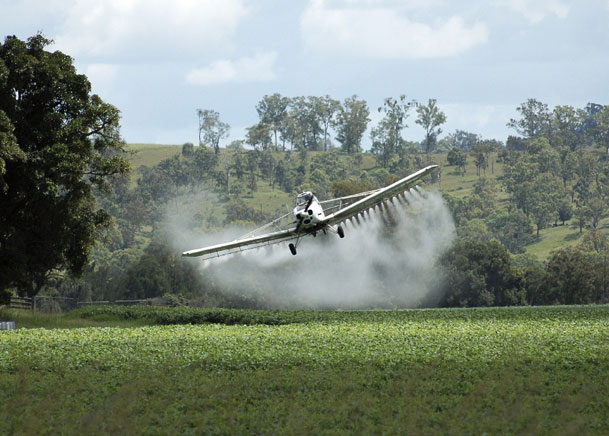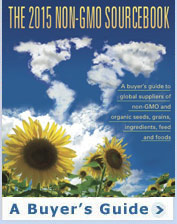New GMOs, herbicides threaten to force family off organic farm
By Ken Roseboro
Published: October 6, 2014
Category: GMO Environmental Risks

To access all the articles in this month's issue of The Organic & Non-GMO Report, SUBSCRIBE NOW.
Note: This article is about the challenges facing a family whose organic farm is threatened by new genetically modified, herbicide resistant crops and the herbicides used with them. The family did not want to reveal their names for fear of negative repercussions from their conventional farming neighbors. As a result, the family’s names and location of their farm have been kept confidential.
Laura often wakes up in the middle of the night fearing for the future of her family’s organic farm. Her fear is a cloud of toxic herbicides drifting over her farm, killing her crops and bees, threatening her family’s health, and ultimately forcing her family to leave their beloved farm.
Unfortunately, Laura’s nightmare scenario is a very real possibility with the proposed introduction of new crops that are genetically engineered to withstand sprays of dicamba and 2,4-D herbicides. As farmers plant these two GM crops, which are likely to receive approval soon by US government agencies, they will be spraying massive amounts of the two herbicides that are known to drift and kill “non-target” crops growing on nearby farms such as Laura’s.
Ecological diversity
Laura’s organic farm is a treasure of biodiversity in a sea of large-scale, industrial GMO corn and soybean farms. Along with Laura, the farm is owned and operated by her husband and several relatives. The farm produces organic grains and vegetable seed and has been certified organic since the mid-1970s.
“Our farm predates GMO technology,” Laura says.
Laura and her family focus on harvesting the best crops, saving seeds from those crops, and planting those seeds generation after generation to produce varieties that are enduring and adapted to their regional environment.
They work with plant breeders to develop seed varieties well suited to organic production.
“Seeds are a sacred thing,” Laura says. “Everything we have now is built on farmers selecting seeds for millennia. All of that genetic diversity is a great gift. Seeds should not be owned, patented, or controlled.”
Laura’s farm is ecologically diverse. In addition to grains, cover crops, and vegetables, they have also planted many varieties of trees.
“We have worked to facilitate an ecosystem on the farm,” Laura says. “We do everything we can to welcome pollinators.”
Protecting corn from GMO contamination
Genetically modified crops grown on neighboring farms are a major contamination threat to Laura’s organic corn. She must take special care to prevent their corn varieties from being cross-pollinated by GMO crops. “We time the planting of our crops so it is outside the window of pollination of our neighbors’ corn,” Laura says.
However, this doesn’t always work; a cold spring can slow growth of Laura’s corn, causing pollination to occur at the same time as their neighbors’ corn.
She and her family harvest their corn by hand and check every ear for off-color GMO kernels, which are then pried out with a screwdriver. In fact, the corn is checked three times for GMO kernels. They also send their corn to a laboratory for GMO testing.
Painstaking efforts have helped preserve the non-GMO status of their organic corn seed stock, but Laura says, “There have been years where our crop was a total loss because there was so much GMO contamination.”
Herbicide drift damage: “This gets personal”
While GMOs are a big threat, they are one part of a bigger issue of pesticides threatening the existence of Laura’s farm. “This goes far beyond the issue of pollen drift from GMOs,” she says.
Laura has suffered crop losses from glyphosate herbicide, which drifted over their farm from neighboring fields. Glyphosate, which is the main ingredient in Roundup herbicide, is used extensively with Monsanto’s Roundup Ready GM crops. Laura’s son’s vegetable patch was destroyed as well as tomato plants.
“This gets personal,” she says.
There was also a disturbing loss of bees. For many years, a local beekeeper has brought his hives to Laura’s farm because of its biodiversity and rich pollen sources. Last year, the beekeeper told Laura that he lost a significant number of bees on their farm.
“We were shocked because we try to create a safe haven for bees,” Laura said. “Bees are the canary in the coal mine. If the environment is toxic for them, it means it’s toxic for us.”
2,4-D and dicamba GMO crops are a major threat
The herbicide drift threat to Laura’s farm will be much greater now that the US Department of Agriculture has approved new GMO crops that are resistant to 2,4-D and dicamba. These herbicides are known to volatize—turn from a liquid to a gas—and drift for miles, killing other plants in their wake. Farmers are likely to plant the new GMO crops because weeds are rapidly becoming resistant to glyphosate, and GMO supporters say farmers need “new modes of action” to overcome the resistance. Opponents, including weed scientist David Mortensen of Penn State University, say biotech companies are putting farmers on a “GMO-herbicide treadmill” and that weed resistance is inevitable with 2, 4-D and dicamba as it has been with glyphosate.
Laura thinks her GMO-growing neighbors will grow these crops. “The thing that is so insidious about 2,4-D resistant GMO crops is that if one farmer adopts this technology, then any neighboring farmer would be in the same situation as I am (susceptible to herbicide drift). This will lead to more rapid adoption by other farmers,” she says.
Further, farmers will mix glyphosate with 2,4-D or dicamba and will have to spray thousands of acres, possibly in windy conditions. “The tank mix of glyphosate and 2,4-D is way more destructive than glyphosate and 2,4-D sprayed individually,” she says.
“Our crops aren’t 2,4-D and dicamba ‘ready’ and neither are we”
This nightmare scenario is what wakes Laura up in the middle of the night and keeps her awake the rest of the night.
“Even though we’ve spent nearly 40 years building this wonderfully diverse and resilient system that’s based on stewarding the ecology of the land, there is no way we can protect our crops and our farm from the introduction of these crops. We have already seen enough herbicide drift damage on our farm. Our crops aren’t 2,4-D and dicamba ‘ready’ and neither are we,” she says.
That is why Laura and her family have talked about moving.
“If these crops are released we don’t know if we want to live here,” she says.
© Copyright The Organic & Non-GMO Report, October 2014




